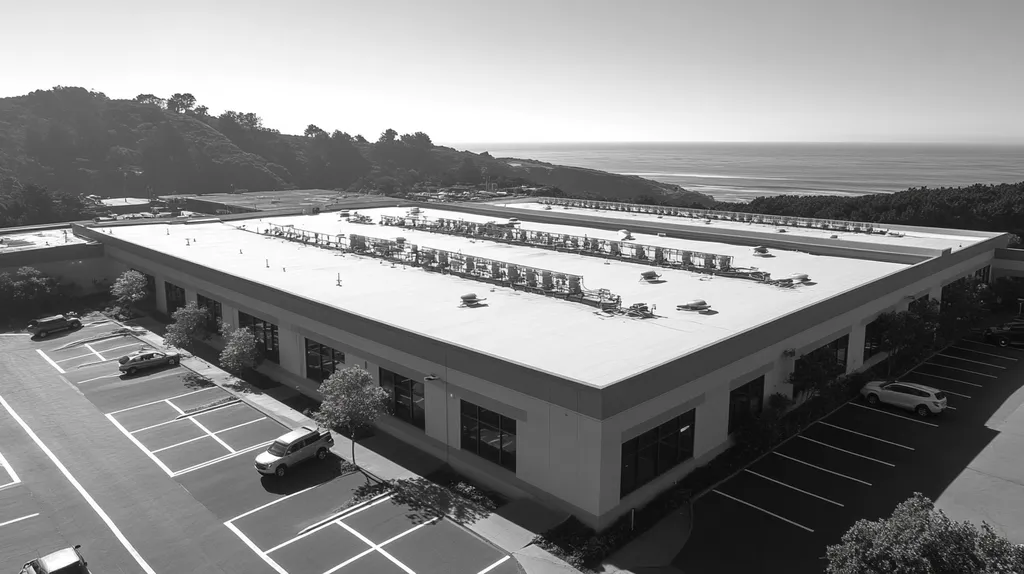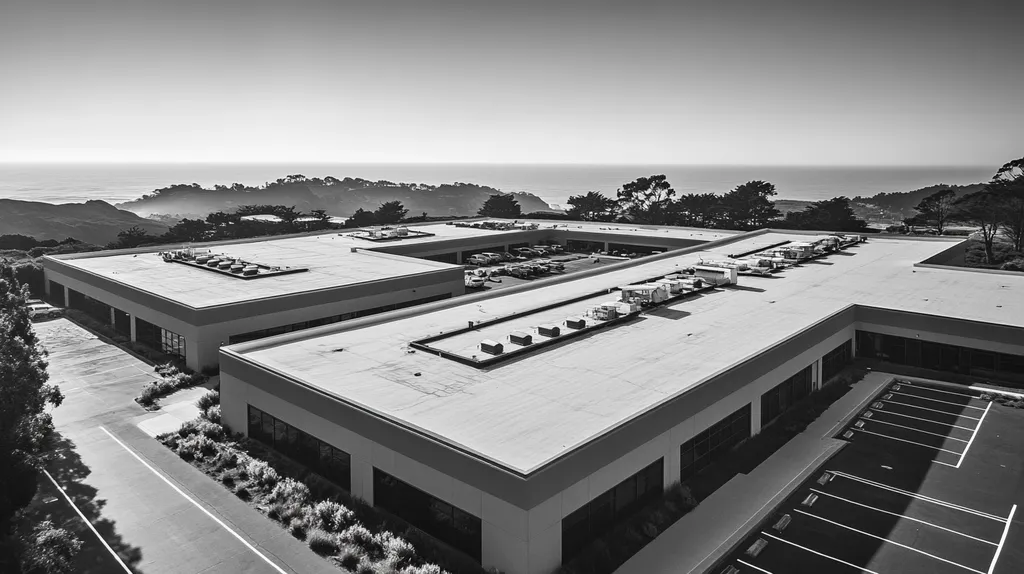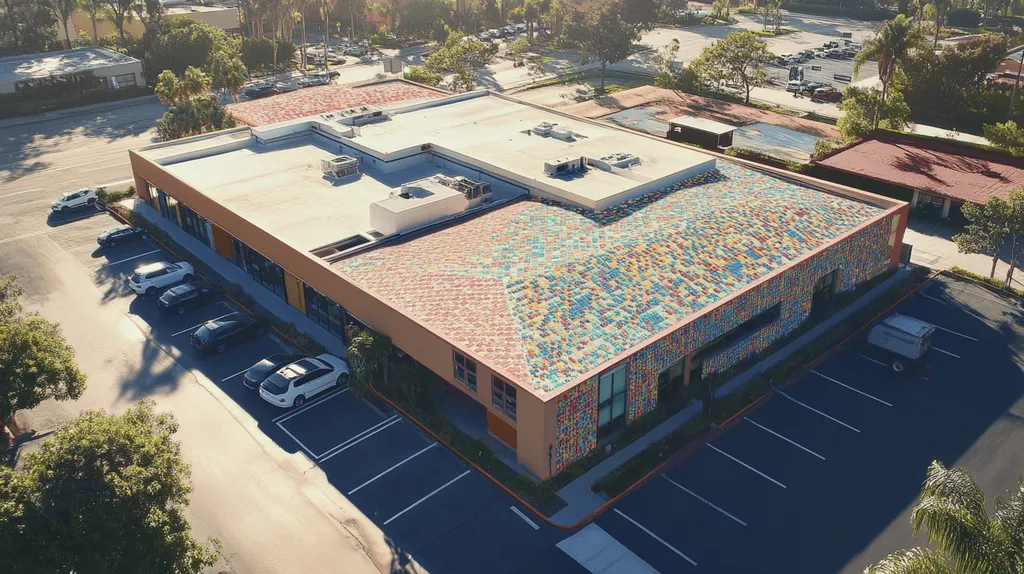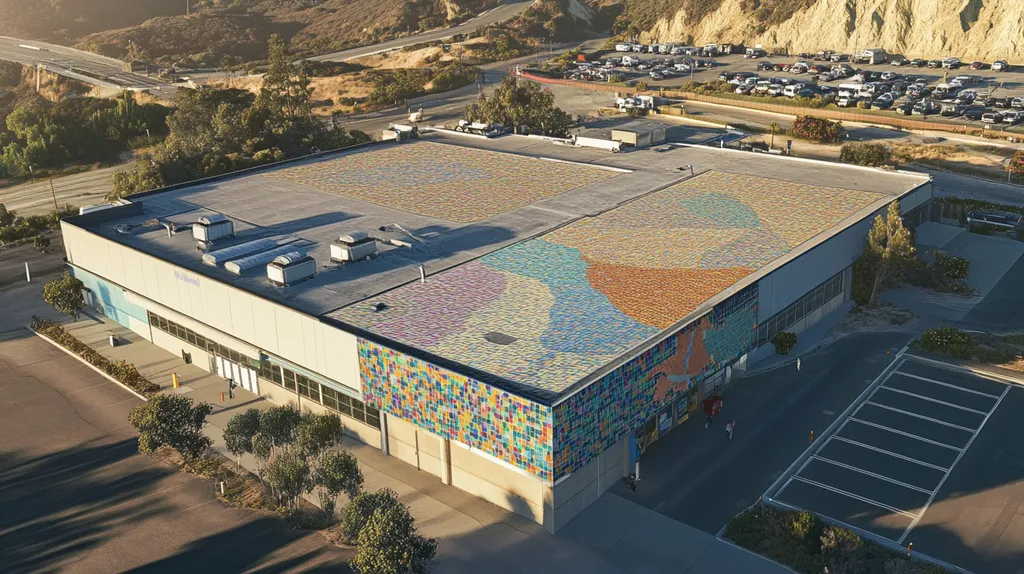Welcome to today’s Battle Royale featuring two roofing heavyweights: “TPO” in the east corner versus “PVC” in the west!
Tonight’s showdown pits these contenders against each other across six punishing rounds designed to test every aspect of their performance for VOC Levels and Safety for Commercial Roofs.
At stake? Millions in potential costs, decades of building protection, and the critical performance demands of modern commercial and industrial facilities.
Our professional judging panel will evaluate each round on technical merit, real-world performance, and value delivery. After all six rounds, we’ll declare our ultimate champion.
Ladies and gentlemen, facility managers and building owners… it’s time to rumble!
ROUND 1: INITIAL COSTS & INSTALLATION
When it comes to commercial roofing, the stakes couldn’t be higher. Every dollar spent on initial installation impacts both immediate budgets and long-term building protection. The adhesives and sealants used in these systems not only affect installation costs but also play a crucial role in maintaining roof system integrity during severe weather events.
Material Expenses
The volatile organic compound (VOC) content in roofing adhesives and sealants significantly influences material selection and costs. While sealants typically have higher VOC content limits (450 g/L) compared to adhesives (250 g/L), these regulations directly impact product availability and pricing. (source: Professional Roofing)
TPO materials generally cost 15-25% less than their PVC counterparts. This price difference stems from simpler manufacturing processes and less expensive raw materials.
PVC’s higher material costs reflect its advanced chemical formulation and superior resistance properties. However, these enhanced features often translate to longer service life.
In the material expenses category, TPO claims the ADVANTAGE due to its significantly lower upfront costs.
Installation Complexity
TPO installation follows straightforward protocols that most qualified roofing crews can execute efficiently. The material’s flexibility and wider sheets reduce the number of seams needed.
PVC requires more specialized installation techniques and careful attention to detail, particularly around joints and flashings. The material’s rigidity can make it more challenging to work with, especially in complex roof geometries.
The installation process for both materials demands precise attention to adhesive application and curing times to ensure proper bonding. However, TPO’s simpler handling characteristics give it the ADVANTAGE in this category.
Project Timeline
TPO installations typically progress more rapidly due to larger sheet sizes and easier handling. Most projects can be completed 20-30% faster than comparable PVC installations.
PVC installations require additional time for proper setup and seam welding. The more complex installation process often extends project timelines, though this thoroughness contributes to long-term performance.
When considering project duration and its impact on facility operations, TPO earns the ADVANTAGE with its faster completion times.
ROUND 1 WINNER: TPO
ROUND 2: DURABILITY & LIFESPAN
When evaluating commercial roofing systems, durability and lifespan considerations extend far beyond simple weather resistance. These factors directly impact worker safety, environmental compliance, and long-term facility protection. The stakes are particularly high when considering VOC exposure during installation and maintenance, which can affect both worker health and building occupant safety.
Chemical Resistance and Safety
VOC emissions during installation pose significant health risks to workers, including nausea, headaches, and respiratory irritation. TPO installations typically generate lower VOC emissions during heat welding, making them a safer choice for installation teams. (source: WorkSafeBC)
PVC roofing demonstrates superior chemical resistance once installed, particularly against industrial pollutants and harsh cleaning agents. This resistance helps maintain membrane integrity and reduces the need for frequent maintenance exposure.
While both materials have their merits, PVC claims the ADVANTAGE due to its exceptional chemical resistance and long-term safety profile.
Weather Impact Resilience
TPO membranes offer reliable protection against UV radiation and standard weather conditions. However, they can show accelerated degradation in environments with extreme temperature fluctuations or prolonged heat exposure.
PVC roofing exhibits remarkable stability across diverse weather conditions, from intense heat to freezing temperatures. Its molecular structure provides superior resistance to thermal cycling and environmental stressors.
For weather impact resilience, PVC takes the ADVANTAGE with its consistent performance across challenging environmental conditions.
Maintenance Requirements
TPO systems typically require more frequent inspections and maintenance interventions, particularly in high-stress areas like seams and flashings. Their maintenance needs increase notably after the first decade of service.
PVC roofing demonstrates exceptional durability with minimal maintenance requirements. Its inherent flexibility and weldability make repairs simpler when needed, reducing exposure to potentially harmful substances during maintenance.
The maintenance category gives PVC the ADVANTAGE due to its lower lifetime maintenance demands and simplified repair procedures.
ROUND 2 WINNER: PVC
ROUND 3: PERFORMANCE FACTORS
In the high-stakes world of commercial roofing, performance factors can make the difference between a reliable shield and a costly liability. VOC regulations increasingly shape how roofing materials perform under real-world conditions, affecting everything from installation methods to long-term durability. Understanding these performance factors is crucial for making informed decisions that protect both buildings and bottom lines.
Durability Under Stress
VOC regulations significantly impact product formulations and application methods, affecting how roofing materials perform under stress. Maximum allowable VOC contents vary by region, influencing product availability and installation procedures. (source: Buildings Magazine)
TPO membranes exhibit excellent flexibility and resistance to tears, making them resilient under normal stress conditions. Their wider sheets and fewer seams help distribute stress loads more evenly across the roof surface.
PVC roofing demonstrates superior puncture resistance and maintains its structural integrity even under heavy foot traffic and equipment loads. Its molecular structure provides enhanced protection against physical damage.
In durability under stress, PVC claims the ADVANTAGE due to its superior puncture resistance and structural stability.
Temperature Resilience
Temperature fluctuations create significant challenges for roofing systems, affecting both material integrity and VOC emissions. Modern roofing must maintain performance across extreme temperature ranges while meeting strict environmental standards.
TPO systems perform adequately in moderate conditions but can show signs of accelerated aging when exposed to prolonged high temperatures. Heat aging can affect seam strength and overall membrane performance.
PVC roofing maintains exceptional stability across extreme temperature ranges. Its chemical composition resists thermal degradation and helps preserve weld strength even in challenging conditions.
For temperature resilience, PVC takes the ADVANTAGE with its superior thermal stability and consistent performance.
Resistance to Chemical Exposure
Chemical resistance becomes increasingly critical as commercial facilities face diverse environmental challenges. Roofing systems must withstand exposure to industrial emissions, cleaning agents, and atmospheric pollutants.
TPO materials offer basic chemical resistance suitable for standard commercial environments. However, they can show vulnerability to certain industrial chemicals and concentrated cleaning solutions.
PVC roofing excels in chemical resistance, maintaining its integrity even when exposed to harsh industrial chemicals and pollutants. Its superior chemical resistance helps preserve long-term performance and reduces maintenance needs.
In chemical resistance testing, PVC earns the ADVANTAGE with its exceptional resistance to industrial chemicals and pollutants.
ROUND 3 WINNER: PVC
ROUND 4: MAINTENANCE REQUIREMENTS
Maintaining commercial roofing systems has become increasingly complex as VOC regulations reshape maintenance practices and material choices. Every repair decision now carries implications for building safety, environmental compliance, and occupant health. Understanding these maintenance requirements is crucial for protecting both your investment and the environment.
Regular Inspection Requirements
Complex VOC regulations significantly impact maintenance procedures, with different jurisdictions enforcing varying limits on repair materials and adhesives. The shifting regulatory landscape demands careful attention to maintenance material selection and application methods. (source: Firestone Building Products)
TPO roofing systems typically require bi-annual professional inspections to maintain warranty coverage. These inspections focus on seam integrity, membrane condition, and drainage system functionality.
PVC roofs demand quarterly inspections due to their more complex chemical composition and potential for plasticizer loss. This increased frequency helps identify issues before they compromise system integrity.
In this category, TPO claims the ADVANTAGE with its less demanding inspection schedule.
Repair Complexity
TPO repairs generally follow straightforward protocols using heat-welding techniques. This simplicity reduces the need for VOC-emitting adhesives and sealants during maintenance.
Most TPO repairs can be completed quickly, minimizing facility disruption. The material’s consistent weldability throughout its service life makes repairs predictable and reliable.
PVC repairs require more specialized techniques and often involve chemical bonding agents. While effective, these repairs typically demand more preparation time and careful environmental controls.
The repair complexity category gives TPO the ADVANTAGE due to its simpler maintenance procedures.
Long-Term Maintenance Costs
TPO systems typically maintain their repairability without requiring specialized treatments or primers. This characteristic helps control long-term maintenance expenses and reduces exposure to VOC-containing products.
The simplicity of TPO repairs translates to lower labor costs and shorter facility disruptions. Most maintenance can be performed without extensive surface preparation or conditioning.
PVC systems often require more expensive maintenance materials and specialized labor. Their chemical composition can make repairs more complex as the membrane ages.
For long-term maintenance costs, TPO takes the ADVANTAGE with its more economical repair requirements.
ROUND 4 WINNER: TPO
ROUND 5: SUSTAINABILITY CREDENTIALS
In today’s environmentally conscious market, roofing sustainability transcends simple “green” marketing. Commercial property owners face mounting pressure from regulators, tenants, and investors to minimize environmental impact while maintaining building protection. The stakes are particularly high as VOC regulations reshape material choices and installation practices across the industry.
Environmental Impact
VOC regulations have become increasingly stringent, forcing manufacturers to reformulate roofing materials and adhesives to meet varying regional requirements. These changes directly impact material availability, installation methods, and environmental compliance across different jurisdictions. (source: Firestone Building Products)
TPO systems demonstrate excellent environmental credentials with lower VOC emissions during manufacturing and installation. Their recyclable composition and cleaner production process contribute to reduced environmental impact throughout the material’s lifecycle.
PVC roofing, while durable, faces challenges regarding its environmental footprint. The manufacturing process generates higher VOC emissions, and the material poses more significant disposal challenges at end-of-life.
In environmental impact considerations, TPO claims the ADVANTAGE with its lower emissions and better recyclability profile.
Energy Efficiency
Modern commercial roofing must balance thermal performance with environmental responsibility. Energy efficiency directly impacts both operational costs and environmental footprint.
TPO membranes excel in solar reflectivity, maintaining their white surface longer than many alternatives. This characteristic helps reduce cooling loads and urban heat island effects.
PVC roofing offers good initial reflectivity but may show more significant degradation over time. While still energy efficient, it typically requires more frequent cleaning to maintain optimal performance.
For energy efficiency, TPO takes the ADVANTAGE due to its superior long-term reflective properties.
Resource Conservation
Resource conservation in roofing extends beyond material selection to include installation efficiency and maintenance requirements. Smart resource management reduces waste and minimizes environmental impact.
TPO installation generates less waste due to wider sheets and fewer seams. The material’s simpler composition also requires fewer chemical additives during manufacturing and maintenance.
PVC systems typically demand more resources during production and installation. Their more complex chemical formulation requires additional raw materials and processing steps.
In resource conservation, TPO earns the ADVANTAGE through its efficient material usage and simpler composition.
ROUND 5 WINNER: TPO
ROUND 6: SPECIALIZED APPLICATIONS
In specialized commercial roofing applications, VOC compliance can make or break a project’s success. From food processing facilities requiring pristine environments to manufacturing plants dealing with harsh chemicals, choosing the wrong roofing system can lead to regulatory violations, compromised operations, and premature failure.
Chemical Processing Environments
Federal VOC regulations impose strict content limits on architectural coatings and roofing materials, with state regulations often exceeding these baseline requirements. These standards significantly impact material selection and installation methods for specialized applications. (source: UL)
TPO membranes offer basic chemical resistance suitable for light industrial environments. However, they can show vulnerability when exposed to harsh processing chemicals or concentrated industrial emissions.
PVC roofing demonstrates exceptional resistance to industrial chemicals, acids, and oils. Its molecular structure maintains integrity even under prolonged exposure to aggressive chemical environments.
For chemical processing environments, PVC claims the ADVANTAGE with its superior chemical resistance properties.
High-Temperature Applications
TPO systems perform adequately in moderate heat conditions but can struggle in extreme temperature environments. Prolonged exposure to high temperatures may accelerate membrane aging and affect seam integrity.
PVC roofing excels in high-temperature applications, maintaining its structural integrity and weld strength even under intense heat exposure. Its formulation provides superior resistance to thermal degradation.
When considering thermal performance in demanding environments, PVC takes the ADVANTAGE.
Food Processing Facilities
TPO installations offer good initial cleanliness but may require more frequent maintenance to maintain sanitary conditions. Their seams can create collection points for contaminants if not properly maintained.
PVC systems provide superior resistance to bacterial growth and are easier to clean and sanitize. Their hot-air welded seams create monolithic surfaces that resist contamination accumulation.
For food processing applications, PVC earns the ADVANTAGE through better sanitization properties and contamination resistance.
ROUND 6 WINNER: PVC
AND THE WINNER IS…
After six grueling rounds of technical evaluation, we have our verdict…
In a split decision that had spectators on the edge of their seats, we declare TPO the overall champion with victories in three critical categories: Initial Costs & Installation, Maintenance Requirements, and Sustainability Credentials!
TPO dominated with its cost-effective installation, straightforward maintenance protocols, and impressive environmental performance. This champion proved that sometimes the more accessible contender packs the strongest punch for your bottom line.
But don’t count PVC out! This powerhouse showed remarkable strength in specialized applications, particularly in chemical processing environments and food safety scenarios. When durability and chemical resistance are paramount, PVC remains a formidable choice.
Remember, folks: Every building brings its own unique challenges to the ring. Local climate conditions, regulatory requirements, and specific facility needs can all impact performance. While this analysis offers valuable insights, it’s essential to consult with qualified roofing professionals who can evaluate your specific situation.
In the high-stakes arena of commercial roofing, the true victory comes not from blindly following the champion, but from selecting the contender that best matches your facility’s specific requirements. Choose wisely – your building’s future protection hangs in the balance!
FREQUENTLY ASKED QUESTIONS
Q. What are the initial costs of a commercial roof installation?
A. Initial costs for commercial roofs depend on the material chosen. TPO typically costs 15-25% less than PVC, making it an appealing option for budget-conscious property owners. However, remember, cheaper isn’t always better—it’s essential to consider long-term performance and potential repair needs.
Q. How do durability and lifespan affect industrial roof choices?
A. Durability and lifespan are critical when choosing an industrial roof. PVC generally offers superior chemical resistance and longevity compared to TPO, making it preferable in harsh environments. This means fewer replacements and lower total costs over time, which is music to any facility manager’s ears.
Q. What performance factors are essential for commercial roofs?
A. Performance factors include durability under stress, temperature resilience, and chemical exposure resistance. PVC roofs usually outperform TPO in these areas, particularly in environments with extreme conditions or industrial pollutants. Understanding these helps ensure you’re investing in a reliable, long-term solution.
Q. What maintenance requirements should I consider for a commercial roof?
A. Regular maintenance is key for commercial roofing systems. TPO typically requires bi-annual inspections, while PVC demands quarterly assessments due to its complex composition. Understanding these differences can help you budget and plan maintenance effectively, saving headaches later on.
Q. How do sustainability credentials affect industrial roof decisions?
A. Sustainability is becoming increasingly important for commercial property owners. TPO roofs tend to have lower VOC emissions and better recyclability compared to PVC. By opting for greener materials, you’re not only enhancing your building’s sustainability profile but potentially attracting eco-conscious tenants or investors.
Q. What specialized applications should I consider for my commercial roof?
A. Specialized applications like food processing require roofs that resist contamination and are easy to clean. PVC excels in these environments due to its smooth seams and chemical resistance. Choosing the right material can help ensure compliance and operational efficiency in these sensitive settings.
Q. How do VOC levels impact installation choices for commercial roofs?
A. VOC levels can significantly influence your roof installation methods. Low-VOC options may lead to safer working conditions for installers while complying with regulations. Choosing materials with manageable VOC emissions can save you legal troubles and enhance worker safety, making it a win-win!










